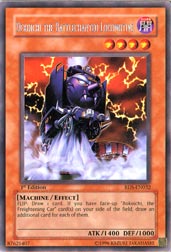Esteemed duelists, welcome to my seminar on Darwinian Deckbuilding. Please note that this seminar is rather avant-garde and the contents thereof are purely representative of myself, and do not necessarily represent the wider philosophy of Duel Academy.
 Well it certainly seems like Return From the Different Dimension is the flavor of the month, doesn’t it? Such a quirky little card, and widely dismissed as “junk” when it first came out two years ago in the Exclusive Pack. (But then, so was “Sakuretsu Armor”. And “Magical Merchant”. And “Metamorphosis”. And so on for many other cards.)
Well it certainly seems like Return From the Different Dimension is the flavor of the month, doesn’t it? Such a quirky little card, and widely dismissed as “junk” when it first came out two years ago in the Exclusive Pack. (But then, so was “Sakuretsu Armor”. And “Magical Merchant”. And “Metamorphosis”. And so on for many other cards.)
Over a hundred years ago, Charles Darwin wrote about the evolution of ecological niches. An animal would evolve to function in a very specific role in its environment. If the niche was too shallow and narrow, then the animal was at greater risk of extinction. For example, if a Munch-Shifted Yellow Friendly Walrus Bird could only survive on Spade-Thorned Silver Blueberries, and couldn’t eat anything else, and then all of the Spade-Thorned Silver Blueberries died off, then that animal species would die off as well.
I look at these “Chaos Return” decks that many duelists are playing with today, and I’m reminded of Darwin’s theories in action. I submit to you that these Return decks have evolved into a very specific ecological niche, where they are only suited to taking on other Return decks, and not much else.
Return decks are stronger when your opponent is helping you by removing your monsters from play. If your opponent plays multiple Bottomless Trap Hole cards, that’s a big plus to you, since it helps you bring out your Big Whammy later on. If your opponent uses Nobleman of Crossout on your face-down Dekoichi, you now have three removed monsters with 1400 ATK for the Big Whammy.
Therefore, when both players are playing Return decks, their synergies feed each other. Your Nobleman of Crossout on that face-down Dekoichi now removes three monsters for each of you. A total of six. Your Bottomless Trap Hole cards now feed each other’s Whammies. And so on. Therefore, it is under these conditions, when everyone is playing a Chaos Return deck, that it truly thrives.
Over the last few months, these decks have carved out a narrower and narrower ecological niche, feeding off the Return cards that were slowly sneaking into other decks. But what happens when you move to a larger ecological niche? What happens when a very narrow and focused Return Deck, evolved specifically to take advantage of the quirks of the current metagame, moves to a completely different ecosystem, which doesn’t have those situations?
In short, what happens when these highly evolved (but narrowly evolved) Return decks go to Japan for the World Championship, and face brute-force bare-bones decks with strength and muscle that use none of these different dimension tricks to feed the Chaos Return deck?
Will it thrive and take overseas competitors completely by surprise? Or will it wind up like the Munch-Shifted Yellow Friendly Walrus Bird and starve?
I suppose we’ll find out in two months.
Class dismissed.